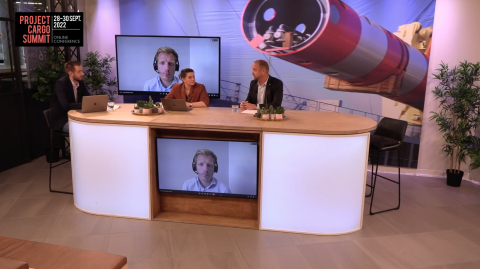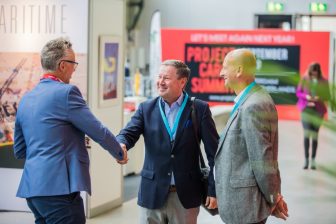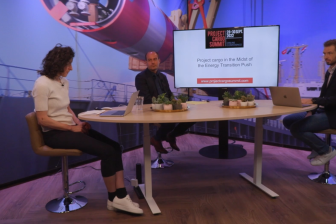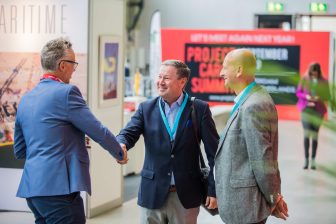
PCS 2022: Project cargo on RoRo vessels is not a phase, but a fantastic option
RoRo vessels have traditionally focused mostly on vehicles and cargo on wheels, and during the recent Project Cargo Summit, Sven Jansen, senior sales manager for high & heavy breakbulk at UECC, confirmed this. “85 percent of the cargo we move is vehicles,” Jansen said.
However, he added that the remaining 15 percent is taken up by breakbulk and project cargo, and that the company is looking to up this share in the future.
With port congestion, geopolitical issues, and Covid 19 restrictions hampering the regular traffic flows, RoRo operators and terminals have come into the spotlight with freight forwarders often deciding to move their cargo onboard these vessels.
There were questions earlier in the year whether this is just a phase, but it seems that things could only get better from here on out, as the demand for project cargo shipments is increasing and deck space in the MPP sector is lacking severely.
Punctual with a Dash of High Frequency
Speaking during the panel discussion named “How RoRo helps keep renewable energy supply chain operating”, Jelle Van Koevorden, managing director DFDS Seaways stressed that RoRo services came to prominence within the project cargo and breakbulk sector due to the fact that “it is an easy way for project forwarders to move cargo from A to B without transshipment”.
Indeed, Jansen added that RoRo operators offer regular liner service with shortsea terminals also having a very quick turnaround with little chance of delay due to the frequent weekly or even daily service. There is even some slack, especially for UECC, when it comes to inducement calls.
Van Koeforden further added that DFDS has seen an increase in project cargo, as chartering vessels in the shortsea market has become a bit more expensive. The increase in project cargo transport for deepsea carriers is even higher, he said.
An All-in-One solution
Both UECC and DFDS have seen an increase in project cargo requests, but this is not only down to the high frequency and punctuality of their respective services. Both companies made their services as efficient as possible, limiting the last-mile requirements. This last-mile service has often been the piece that was missing from the puzzle that made RoRo vessels a complete solution.
What made it possible for UECC to respond to the demands from the project cargo sector is the fact that over the last five years, according to Jansen, the company’s roll trailer fleet jumped from 500 units to 900 units.
It is a similar story for DFDS who provide significant coverage in the European market. “Our core business is point to point, but as we cover the Baltic Sea, the North Sea, the Med, it means that we can cover a whole lot of the European network so that the last mile is very limited,” says Van Koevorden.
He further stated that DFDS has its own terminals in key markets, as well as its own equipment for the end solution.
But, it is not only deliveries within Europe and the respective networks of the two companies. Both stressed that their equipment enables them to deliver cargo to destinations beyond Europe.
“Most of the ports that we call also have deepsea liners calling there,” says Jansen. This means that the company is able to position its roll trailer or MAFI or the deepsea liner’s roll trailer or MAFI to UECC’s port of loading for the customer to place their cargo on. Once the cargo is loaded onto the company’s vessel and transported to a hub port, the roll trailer is discharged and loaded onto a deepsea liner, eliminating the lifting operations, and enabling the cargo to head to its end destination.
He also noted that when a customer has a request for shipping project cargo UECC provides them with a rate that covers the transport from lifting a cargo from the customer’s truck to a UECC MAFI up until delivery from the MAFI to the customer’s truck at the port of destination.
RoRo going green
While there is still a lot of discussion and open questions when it comes to the next fuel that will enable emissions free operations, both companies have already taken steps in that direction.
Fleet decarbonisation is high on DFDS’ agenda and the company has made a decision to have its first vessel operating emissions free before 2025. “We are working on that in our Sustainable Fleet Department which is an isolated project department in our head office in Copenhagen.”
UECC, as Jansen pointed out, has already made decisions when it comes to their fleet choosing to fuel their newbuilds with LNG. The company has also ordered three LNG battery-hybrid vessels, two of which have already been delivered and the third one set for delivery this month.
“Benefit here is that they have the LNG factor but they also have the battery hybrid function. We have filled the keel of our vessels with batteries. So when we come into a port and we are alongside, we can basically switch off the main engine and switch to battery mode,” says Jansen.
Responding to a question whether the ports have the infrastructure needed for their fleet to operate without disruption, Jansen said, “we load our batteries at sea, so if the port is not ready, then, we are.” He also added that the major ports already have shore power facilities.
DFDS has the luxury of being able to invest or co-invest in port infrastructure with its partners. Not only do they sail to 32 ports but eight terminals are DFDS-owned and operated.
“Currently we have four terminals in the pipeline to be equipped with shore power or already equipped with shore power,” says Van Koevorden. The company already has the required infrastructure in place in Copenhagen and Gothenburg while it is implementing shore power projects in Vlaardingen, Gent and Immingam.
Not just a phase anymore
It is safe to say that RoRo is not a phase anymore but a viable option that is here to stay. “We are a good alternative, we are a fantastic alternative, actually, to the MPPs and road transport,” says Jansen
And according to him, it is not a matter of being the alternative, but shortsea RoRo actually being one of the several alternatives. He further noted that the energy supply chain will need more than one solution anyway.
While the DFDS operations are based on high frequency and daily sailings, slightly different to that of UECC, Van Koevorden stresses that RoRo is always a solution as long as they sail to the port that is close to the end destination.
He also expects that the share of project cargo on RoRo vessels will keep growing, even when the MPP market is back to normal, if that ever happens. The high flexibility of these vessels and RoRo terminals is becoming appealing to an increasing number of project forwarders and project cargo owners.




